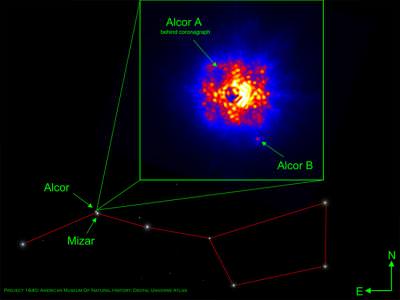Many types of main sequence stars emit in the X-ray portion of the spectra. In massive stars, strong stellar winds ripping through the extended atmosphere of the star create X-ray photons. On lower mass stars, magnetic fields twisting through the photosphere heat it sufficiently to produce X-rays. But between these two mechanisms, in the late B to mid A classes of stars, neither of these mechanisms should be sufficient to produce X-rays. Yet when X-ray telescopes examined these stars, many were found to produce X-rays just the same.
The first exploration into the X-ray emission of this class of stars was the Einstein Observatory, launched in 1978 and deorbited in 1982. While the telescoped confirmed that these B and A stars had significantly less X-ray emission overall, seven of the 35 A type stars still had some emission. Four of these were confirmed as being in binary systems in which the secondary stars could be the source of the emission, leaving three of seven with unaccounted for X-rays.
The German ROSAT satellite found similar results, detecting 232 X-ray stars in this range. Studies explored connections with irregularities in the spectra of these stars and rotational velocities, but found no correlation with either. The suspicion was that these stars simply hid undetected, lower mass companions.
In recent years, some studies have begun exploring this, using telescopes equipped with adaptive optics to search for companions. In some cases, as with Alcor (member of the popular visual binary in the handle of the big dipper), companion stars have been detected, absolving the primary from the expectation of being the cause. However, in other cases, the X-rays still appear to be coming from the primary star when the resolution is sufficient to spatially resolve the system. The conclusion is that either the main star truly is the source, or there are even more elusive, sub-arcsecond binaries skewing the data.
Another new study has taken up the challenge of searching for hidden companions. The new study examined 63 known X-ray stars in the range not predicted to have X-ray emission to search for companions. As a control, they also searched 85 stars without the anomalous emission. This gave a total sample size of 148 target stars. When the images were taken and processed, it uncovered 68 candidate companions to 59 of the total objects. The number of companions was greater than the number of parent stars since some look to exist in trinary star systems or greater.
Comparing the percent of companions around X-ray stars to those that didn’t, 43% of the X-ray stars appeared to have companions, while only 12% of normal stars were discovered to have them. Some of the candidates may be the result of chance alignments and not actual binary systems giving an error of about ±5%.
While this study leaves some cases unresolved, the increased likelihood of X-ray stars to have companions suggests that the majority of cases are caused by companions. Further studies by X-ray telescopes like Chandra could provide the angular resolution necessary to ensure that the emissions are indeed coming from the partner objects as well as search for companions to even greater resolution.


Hmm… This article seems to hint at the existence of small Black Holes?